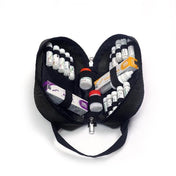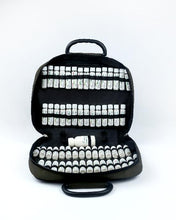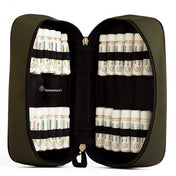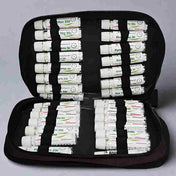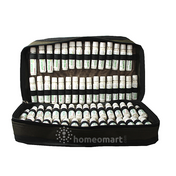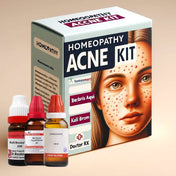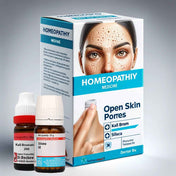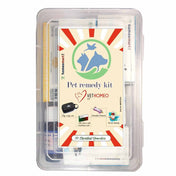Antimonium tartaricum LM Potency Dilution
Antimonium tartaricum LM Potency Dilution - 1/2 Dram (1.6 Gms) / 0/1 is backordered and will ship as soon as it is back in stock.
Couldn't load pickup availability
Description
Description
Synonym: Antim tart
For Alcoholism, Aphthae, Cough, Lungs affections, Psoriasis, Ringworm.
Indications for Antimonium tartaricum LM potency medicine:
Convulsive twitching, Convulsions, Great heaviness in all the limbs and great debility is relieved by Anti.monium Tart
Inflammation of internal organs, Gastric and bilious complaints, Constant nausea -nausea felt in chest s relieved by Antimonium Tart.
The Antimonium Tart child wants to be carried and cries if any one touches it. Peevishness, whining, and crying.
The Antimonium Tart patient's tongue has a thick, white, pasty coat with red papillae showing through.
Intense nausea and vomiting with great effort, with perspiration on forehead, Fullness and sensation of stones in abdomen, especially when sitting bent forward is well relieved by Antimonium Tart.
All the complaints of Antimonium Tart patients worse from Warm drink, also lying in bed especially becoming warm there.There is also worse from cold and damp.
Antimonium Tart has worse on sitting down, when seated, and on rising from a seat, worse sitting bent forward, better sitting erect, worse Lying on side affected. Worse Motion, on every effort to move.
Patient profile: Antimonium tartaricum LM potency medicine
Mind: Bad humor, Excessively peevish and quarrelsome. Discouragement and despair, Lethargy.
Child will not allow itself to be touched.
Head: Dullness, confusion, and bewilderment in the head, which is, as it were, benumbed, with inclination to sleep.
Headache, with palpitation of the heart, and vertigo.
Trembling with the head and hands, with great debility, worse when lying and getting warm in bed, better when sitting up erect and in the cold.
Eyes: Eyes fatigued, requiring sleep, and to be firmly closed. Aching of the eyes.
Confused sight, with sparkling before the eyes, especially on rising from a seat.
Ears: Humming in the ears.
Nose: Violent fluent coryza, with frequent sneezing, ulcerated nostrils, shivering, loss of smell, and of taste.
Nostrils widely dilated.
Face: Face pale, sunken. Convulsive jerking of the muscles of the face.
Teeth: Odontalgia, with very violent pain in morning. Rheumatic toothache of intermittent type. Scurvy.
Mouth: Copious accumulation of saliva in the mouth. Tongue moist, clean, or loaded with a brown coating.
Appetite: Fatty taste in the mouth. Bitter taste in the mouth.
Craving for acid things, or for raw fruits (apples), for cold drinks or thirstlessness. Aversion to all food, especially milk.
Stomach: Empty risings. Constant nausea, sometimes with inclination to vomit, anguish, pressure in the scrobiculus, and headache, mitigated by expulsion of flatus, upwards and downwards.
Vomiting of mucus, with mucous diarrhoea. Pain in the stomach, as if it were overloaded.
Abdomen: Pains in the abdomen, with great moral and physical agitation, and dislike to all kinds of labor.
Spasmodic colic in the abdomen, with violent contraction of the eyelids, and irresistible inclination to sleep.
Incisive pains in the abdomen, as if the intestines were being cut. Pulsations in the abdomen.
Stool and Anus: Constipation, alternating with diarrhoea. Slimy diarrhoea, or yellow, bright brown, or else watery, often preceded by gripings and movements in the abdomen.
Violent burning tickling, extending from the rectum into the glans penis.
Urinary Organs: Very profuse and distressing emission of urine, with tension in the perineum, burning sensation in the urethra, and scanty stream, which is sanguineous towards the end of the emission, with violent pains in the bladder.
Nocturnal calls to urinate, with burning thirst and scanty emission. Involuntary emission of urine.
Male Sexual Organs: Excitation of sexual system. Pain in testicles after checked gonorrhea.
Female Sexual Organs: Severe bearing-down in vagina. Eruption of pimples on the genital organs.
Respiratory Organs: Catarrh, with irritation, which excites coughing, copious accumulation of mucus, and rattling of mucus in the chest. Hoarseness.
Shortness of breathing from suppressed expectoration.
Cough, with heat and moisture of the hands, and perspiration on the head, chiefly on the forehead. Cough, with vomiting of food, after a meal.
About LM potency homeopathy medicines
In the sixth edition of ‘Organon’ Dr. Hahnemann had introduced a new system of dilution and potentization and called it “renewed dynamisation” with a diluting ratio of 1:50,000. It was named as 50 millesimal potency or LM potency by Dr. Pierre Schmidt. In some parts of the world, it is also called as Q potency. It soon got professional acceptance. As on date, it is recognized by different homoeopathic pharmacopoeias including American and Indian.
What are they and how are they denoted?
These homoeopathic potencies are prepared in the diluting scale of 1:50,000 and denoted as 0/1, 0/2, 0/3…..etc. They are generally used up to 0/30.
Perceived advantages
- Highest development of power at each potency level.
- Mildest reaction – no medicinal aggravation.
- Frequent repetition is permitted; every hour or oftener in urgent cases.
- Quick cure in chronic cases where it can be given daily or oftener.
- 0/3 is more subtle than 30C or 200C and the 0/30 is sharper than CM as believed by many classical homoeopaths.
LM potency dosage: Generally LM potencies are administered as follows:
- Take a 4oz (120ml) to 6oz (180ml) clean glass bottle. Fill it 3/4th with water. Take 1or 2 globules of the desired potency (often starting at LM 0/1) and place it into the bottle.
- Succuss the bottle just prior to ingestion 1 to 12 times depending on the sensitivity of the patient. This slightly raises the potency and activates the remedy.
- Take 1, or more teaspoons of the medicinal solution and place it into 8 to 10 tablespoons of water in a dilution glass and stir it. Most cases are started with 1 teaspoon and the amount is increased only if necessary. In children the amount should be 1/2 teaspoon. Infants may only need 1/4 of a teaspoon.
The dosage of the medicinal solution can be carefully adjusted to suit the sensitivity of the individual’s constitution
Note: We dispense SBL LM potency medicines in 1/2, 1 & 2 dram plastic containers, image for illustrative purpose only.




